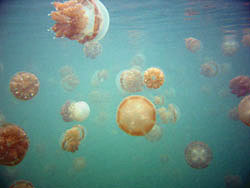Jellyfish Lake: Kakaban Island
Usually when divers talk about a jellyfish lake, they
refer to the jellyfish lake on Palau far out in the Pacific Ocean. The truth
be told: The Indonesian archipelago holds numerous lakes like the one on
Kakaban Island – quite close to Maratua. And it certainly was an experience.
The pioneers who first dove the lake on Kakaban Island had to endure a long
and arduous walk through hilly jungle and across razor-sharp rocks fighting
off swarms of thirsty ”blood-sucking flies” in 40 degrees C and an air
humidity of 95% - in full scuba, of course. All this for a dive in a salt
water lake full of jellyfish, sea cucumbers, crabs, disgusting mangrove (if
you ever snorkelled in between mangrove trees, you'll know what I mean) and
… oh… a beautiful, indigenous goby and lots of nudibranchs, tunicates,
sponges and lots more. A completely isolated, self-serving eco-system.
Of course, all this hassle in a recreational sport won't do, so a local
fisherman was hired to make a wooden path from the beach to the lake with
stairs and steps and rails and everything. When we visited he had been at it
for a couple of years and needed only to cover the last 200 metres in the
middle of the path. It still was a sweat-drenching ordeal – for us, that
is...

During the last glacial or ice age which ended some 10,000 years ago sea level was about 120-130 metres lower than today. The melting of the ice caps caused a huge sea level rise – higher than today – and an increase in temperature in the Northern Hemisphere until about 5,500 years ago. Then the temperature decreased again and sea level fell to present day level – trapping the poor jellyfish in the lake on Kakaban Island. The name Kakaban actually means “hug” in the local dialect as the island hugs the jellyfish lake from the outside sea. Kakaban is also part of the Kepulauan Sangalaki Marine Wildlife Reserve.
The jellyfish in the lake used to sting but has lost
their ability due to a lack of natural predators. And a good thing too,
‘cause we were quite clearly outnumbered – there were thousands of them. One
of at least four different species spent most of the time bottom up on the
bottom feeding. The other three were all very busy swimming back and forth
exposing their built-in algae to the sunlight thus creating photosynthesis.
There seemed to be two dominant fish species though we weren’t able to
identify them. Hiding between the roots of the mangrove trees we found a
beautiful dark-coloured goby with lots of small blue-green spots down the
side.
By the way, the blood-sucking flies turned out to be horse botflies. Their
bite still hurts like hell but they don’t carry deceases, and knowing what
they are makes the trip from the beach to the lake a little less scary. They
should in no way prevent you from doing the trip. Lene and I shared our
scuba gear and took turns diving and snorkelling, respectively.

